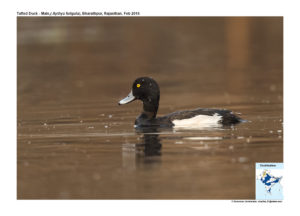Tufted Duck

Tufted Duck Aythya fuligula
Etymology:
- Aythya : Greek word for aithuia unidentified seabird mentioned by Aristotle
- Fuligula : Latin word fuligo – soot; gula – throat
Vernacular names: Sind: Turando, Runharo, Hindi: Dubaru, Ablak, Rahwara, Sans: Shika majjika, Pun: Bodal murgabi, Ass, Ben: Bamoni hanh, Nepal: Malak, Guj: Kalwetio, Chotili kabari batak, Mar: Kala barda, Raja sari, Shendi badak, Ta: Kurungalian, Te: Nalla chiluwa
Distribution in India: Wide spread winter visitor in India.
Description: Size of 40–47 cm; wt. of male 600–1020 g, female 560–930 g; wingspan of 65–72 cm. The adult male is all black except for white flanks and a blue-grey bill with gold-yellow eyes. It has an obvious head tuft that gives the species its name. The adult female is brown with paler flanks and a yellow iris. The juvenile resembles female, but young male has darker head and foreneck, with somewhat vermiculated back patterning, and becomes much like adult male by Dec, albeit with duller iris, greyer flanks and narrower flight and tail feathers.
Habitat: It is found during breeding in large, deep, freshwater lakes, ponds and reservoirs with marginal and emergent vegetation, open waters and preferably islands, mainly in lowland areas. In winter, found in brackish lagoons and tidal bays, as well as freshwater wetlands.
Food Habits: It eats seeds and green parts of aquatic plants, molluscs, crustaceans, crayfish and aquatic insects. It feeds mostly by diving, also upends, dips head or picks items from surface .On shore it feeds on grain and may take food from humans. Non-diving birds use two techniques with mussels: those < 16 mm in length are strained from water flow generated in the bill (suction-feeding), while larger ones are picked up and handled singly. With suction-feeding the more profitable technique, and diving birds prefer suction-feeding for all mussels up to 16 mm in order to minimize costs of diving and selectivity for small mussels increases with diving depth; in winter, mussels up to three times a duck’s body mass can be taken in single day. Forages both by day and night.
Breeding Habits: They breed from May- June in Continental Europe. The nest is made of grass and sedges, lined with thick layer of down and vegetation, on ground, among grass tussocks, bushes or in open, especially when on islands. They are single-brooded. They lay a clutch of 8–11 eggs . The incubation period is 23–28 days, by female alone. The chicks are precocial and fledging in 45–50 days, cared for by female, who stays with young for 29–42 days.